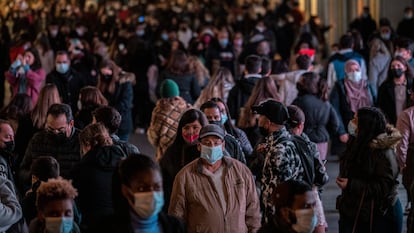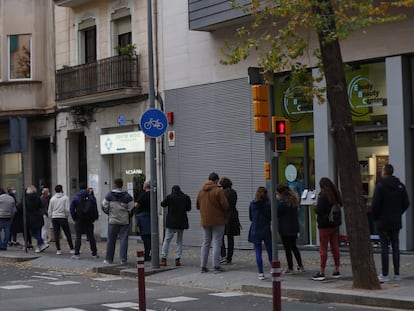Flood of new coronavirus infections and progress of third doses should see immunity levels rise in Spain
Experts, however, are warning that January will be complicated, with the sixth wave of the pandemic peaking around the second week of the month

The start of the New Year is going to be complicated in Spain. The number of people left seriously ill or who die after contracting Covid-19 is going to increase. The omicron variant is going to put the healthcare system under renewed pressure, with staffing levels decimated by a flood of infections. And more than a million people will spend the first days of 2022 in isolation after having tested positive for the coronavirus in recent days.
But once this critical point is over, the immunity developed by a large part of the population after having overcome an infection or thanks to a third dose of a Covid-19 vaccine points to a more hopeful future. Some very preliminary forecasts suggest that the sixth wave of the pandemic in Spain will peak in the second week of January, and while very few experts now expect the sought-after herd immunity to be achieved with a virus that brings surprise after surprise, many are expecting a scenario with fewer infections and milder cases, apart from for high-risk groups and those who are still not fully vaccinated.
Quique Bassat, an epidemiologist and researcher at the ISGlobal institute in Barcelona, believes that the impact of this wave “along with the advance of the booster shots,” will have an important effect on the immunity of the population. Above all, taking into account that a “good part” of the infections are taking place among those who have not completed or begun the recommended doses. “We will come out of this stronger, but some tough weeks are ahead,” he explains. “The margin for infections to keep growing is now not so high, but after reaching the peak the pressure on the system will remain high for two weeks,” he adds.
According to the latest data from the central Health Ministry, more than a million people have been infected with the coronavirus since December 13, half of them in the last week of the year. This rising trend is expected to remain above 100,000 daily new positives for some days yet. As well as naturally acquired immunity, that achieved thanks to the booster shots must be included as well. So far, more than 13 million of Spain’s citizens have received these shots.
Among the people to receive this booster dose are healthcare staff, people with suppressed immune systems, 88% of the over-70s and 75% of the 60-69 group. These data are viewed favorably by the experts, given that they are in line with the European Union average. But they do not place Spain among the best countries on the continent, as has been the case during the rest of the vaccination campaign.
The importance of the third dose is reflected in the studies carried out so far that show that the protection offered by the first shots of the mRNA vaccines – Pfizer-BioNTech and Moderna – starts to decline after the fourth month, before the same thing happens with the AstraZeneca or Janssen vaccines. Miguel Hernán, a professor of epidemiology at Harvard University, studied this effect in the countries that began their vaccination campaigns first, such as the United States, Israel and the United Kingdom.
Reducing the risk
“Not only does protection against symptomatic illness fall, but also against hospitalization,” he explains. “Our studies show that the booster shots reduce the risk of serious illness in all age groups. In a context of high incidence, it would be important to reduce the gap between the second and third dose, as other countries have done.”
Spain is still administering booster shots six months after the second dose, but the board of experts advising the central government and the regions on the vaccination strategy are studying reducing this time to three or even two months. “The available studies show that it is safe to do this and this causes a strong immune response that protects the organism against the virus,” explain sources from the board.
Santiago Moreno, the head of infectious diseases at the Ramón y Cajal Hospital in Madrid, agrees that it would have been better to move faster with the administration of booster shots and thinks that perhaps the message about the benefits and safety of this shot have not been properly transmitted.
He cites an example. “I knew of a case of one person who lives with another who suffers lymphoma, and five months later had not got the third shot for fear it wasn’t safe. There is no danger in getting vaccinated early, but it is to not do so once your defenses have fallen,” he explains.
Amós García, the president of the Spanish Vaccinology Association, argues that the vaccination strategy has adapted to the scientific evidence. “First, two basic criteria were followed: increasing the protection of those with suppressed immune systems and maintaining that of the over-60s. And later, for the administration of the third dose in the healthy and younger population, which has been done as the evidence was consolidated. As [Uruguayan author] Mario Benedetti wrote, ‘when we had all the answers they changed the questions.’ We are faced with a scenario of great uncertainty and the role of science is to eliminate that as the certainty increases.”
Regional differences
As the vaccination campaign progresses in Spain, there are significant differences being seen between regions. While these are lesser among the over-70s (all territories have vaccinated more than 80% of the target population for this age group with a third dose), some such as the Balearic Islands are up to 15 points below the national average for the 60-69 age group, which is 75%.
The Balearic government believes that this is due to a combination of factors: greater reticence among the population, which has prompted some to reject the third dose; the appearance of the omicron variant, which is preventing those with infections to get the third shot; and the strategy followed until now, which prioritizes vulnerable groups and seniors.
In order to give the process a boost, the Balearics are going to open several dozen vaccination lines and have also requested the incorporation of 10 of the 150 mobile teams that the Spanish army has offered to the regions to help with the campaign.
Other straggling regions, such as the Canary Islands, have already put personalized measures in place to persuade people to get their shots, as well as keeping vaccination points open without need for appointments every day of the year, including Christmas and New Year.
In the 50-59 group, the region with the lowest level of booster shots is Andalusia, with 13% – 15 points below the country average. The difference rises to 17 points among those who were given the single-dose Janssen shot. In the former case, the regional government puts this lower percentage down to the fact that a strategy of descending age is being used, and until now vaccination has only been opened to the over-58s. In the latter, Andalusia used this medication for the homeless, visiting Erasmus students who later left the country, temporary workers and sailors, which in some cases is making it difficult to locate them now.
The percentage of the 40-49 group who have received the booster shot in all of Spain remains small, and barely exceeds 16%.
Vaccination of children aged five to 11, which began on December 15, has been the latest trump card in a bid to bring the pandemic under control. Of the 3.35 million youngsters in this age group, 27% have already received their first shot, which must be followed by a second eight weeks later. This has been one of the groups that has seen the highest levels of infections in the current wave, given that it was not vaccinated at all. The 14-day incidence has exceeded 4,400 cases per 100,000 inhabitants in regions such as Navarre (one in every 23 children). As in previous waves, practically all children suffer either mild or even asymptomatic infections.
Children who get infected now and have not received any vaccine doses will receive a single shot four weeks after they were diagnosed or symptoms began. Those who have received the first injection will have to wait the same time period for the second one, maintaining the eight-week interval between the two shots if possible.
Tu suscripción se está usando en otro dispositivo
¿Quieres añadir otro usuario a tu suscripción?
Si continúas leyendo en este dispositivo, no se podrá leer en el otro.
FlechaTu suscripción se está usando en otro dispositivo y solo puedes acceder a EL PAÍS desde un dispositivo a la vez.
Si quieres compartir tu cuenta, cambia tu suscripción a la modalidad Premium, así podrás añadir otro usuario. Cada uno accederá con su propia cuenta de email, lo que os permitirá personalizar vuestra experiencia en EL PAÍS.
¿Tienes una suscripción de empresa? Accede aquí para contratar más cuentas.
En el caso de no saber quién está usando tu cuenta, te recomendamos cambiar tu contraseña aquí.
Si decides continuar compartiendo tu cuenta, este mensaje se mostrará en tu dispositivo y en el de la otra persona que está usando tu cuenta de forma indefinida, afectando a tu experiencia de lectura. Puedes consultar aquí los términos y condiciones de la suscripción digital.
More information
Últimas noticias
Mexican peso defies uncertainty with forecasts of a new period of stability in 2026
Meghan Markle’s year of redemption: Numerous projects, some setbacks and a brand that is finally taking off
David King, chemist: ‘There are scientists studying how to cool the planet; nobody should stop these experiments from happening’
The end of the American dream gives way to Guatemalan opportunity
Most viewed
- Sinaloa Cartel war is taking its toll on Los Chapitos
- Oona Chaplin: ‘I told James Cameron that I was living in a treehouse and starting a permaculture project with a friend’
- Reinhard Genzel, Nobel laureate in physics: ‘One-minute videos will never give you the truth’
- Why the price of coffee has skyrocketed: from Brazilian plantations to specialty coffee houses
- Silver prices are going crazy: This is what’s fueling the rally










































